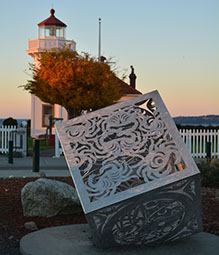 Native American artworkTwo points should be made regarding the examples of Indian artistic expression that you will see throughout your walking tour of Lighthouse Park. The first is that they represent only a tiny fraction of the full range of artistic expression among the Lushootseed language group. The use of the language itself was a prized skill, and a premium was placed on well-told stories and the timely use of proverbs. Unfortunately, this art form is not recoverable, and even the original languages are in danger of dying despite heroic efforts to preserve and maintain them. Similarly, throughout the past and into the early 20th century, women produced a variety of attractive textiles using the wool of mountain sheep and small “wooly” dogs raised specifically for their fur. The dogs are now extinct, and very few examples of the ancient textiles remain today, although some impressive woven hats and watertight basketry have been recovered.
Native American artworkTwo points should be made regarding the examples of Indian artistic expression that you will see throughout your walking tour of Lighthouse Park. The first is that they represent only a tiny fraction of the full range of artistic expression among the Lushootseed language group. The use of the language itself was a prized skill, and a premium was placed on well-told stories and the timely use of proverbs. Unfortunately, this art form is not recoverable, and even the original languages are in danger of dying despite heroic efforts to preserve and maintain them. Similarly, throughout the past and into the early 20th century, women produced a variety of attractive textiles using the wool of mountain sheep and small “wooly” dogs raised specifically for their fur. The dogs are now extinct, and very few examples of the ancient textiles remain today, although some impressive woven hats and watertight basketry have been recovered.
We do have some carved bone, stone, and horn artifacts from elsewhere in the Puget Sound region that have been dated back to 5,000 years ago. The Burke Museum on the University of Washington campus has two human figures carved in elk antler from approximately 800 and 1,800 years ago. They are remarkably similar and both feature the welcoming hand that may be seen here in the metal cube in the traffic circle.
So examine and enjoy the artistic works on this walk, but keep in mind that they are but a tiny sliver of the much deeper and broader patterns of cultural expression among the local Native Americans.
The second point is related to the first, in that the carved and stamped images that you see are much more meaningful among Indians than simple decoration. These are not just “sculpture” or “design,” they embody or possess spiritual power. Every image—salmon, Orca, eagle, crab—evokes multiple legends, stories, songs, dances, and other cultural patterns that explain the universe and the role of people within it. Indian memories are fundamentally ancestral, both in terms of recent relatives no longer living as well as those ancestors from an ancient “myth-time” when humans and mythical creatures shared the earth. So what a visitor may find interesting or curious, represents for Native Americans a multi-layered and spiritual reassurance of the continuation of their ancestors, and therefore their culture. This worldview explains the ongoing tension between those seeking development and change, and those who do not want their ancestors disturbed or dis-respected. A letter from the Tulalip Tribes in 2007 regarding development of land along this shore illustrates the point:
“To the Tulalip people, this is not an archeological site, and its value is not in scientific analysis. This is a living site of our ancestors, and it has immeasurable cultural and spiritual values…Places where the remains of our villages and gathering places remain intact must be preserved in order to preserve the living culture of the Tulalip Tribes.”
Copyright 2015, Mukilteo Walking Tour. All rights reserved.